Analysis of Recruitment and Selection Processes: Tesco's Approach
VerifiedAdded on 2020/02/03
|12
|2776
|46
Report
AI Summary
This report provides a comprehensive analysis of recruitment and selection processes, using Tesco as a case study. It begins by identifying how organizations, like Tesco, plan recruitment using internal and external sources, including transfers, promotions, and press advertisements. The report then examines the impact of legal and regulatory frameworks, such as the Equality Act 2010 and the Employment Act 2002, on recruitment activities. It further details the preparation of documents used in the selection process, such as job descriptions, and outlines the steps involved in planning and taking part in a selection interview, including research, skill comparison, and follow-up. The report covers both internal and external recruitment sources and concludes with an overview of the interview process. The document explores the application of these concepts within the context of Tesco's HR practices.
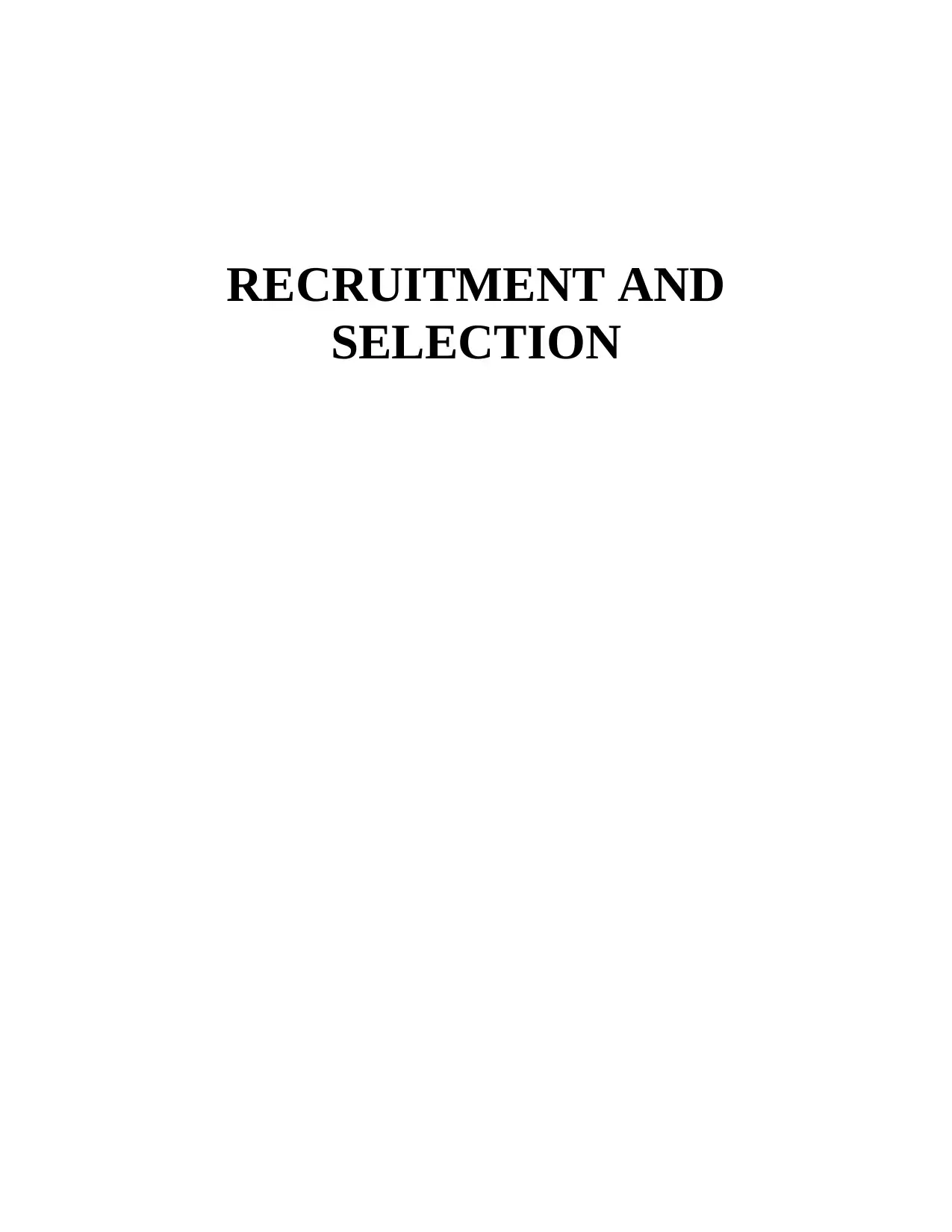
RECRUITMENT AND
SELECTION
SELECTION
Paraphrase This Document
Need a fresh take? Get an instant paraphrase of this document with our AI Paraphraser
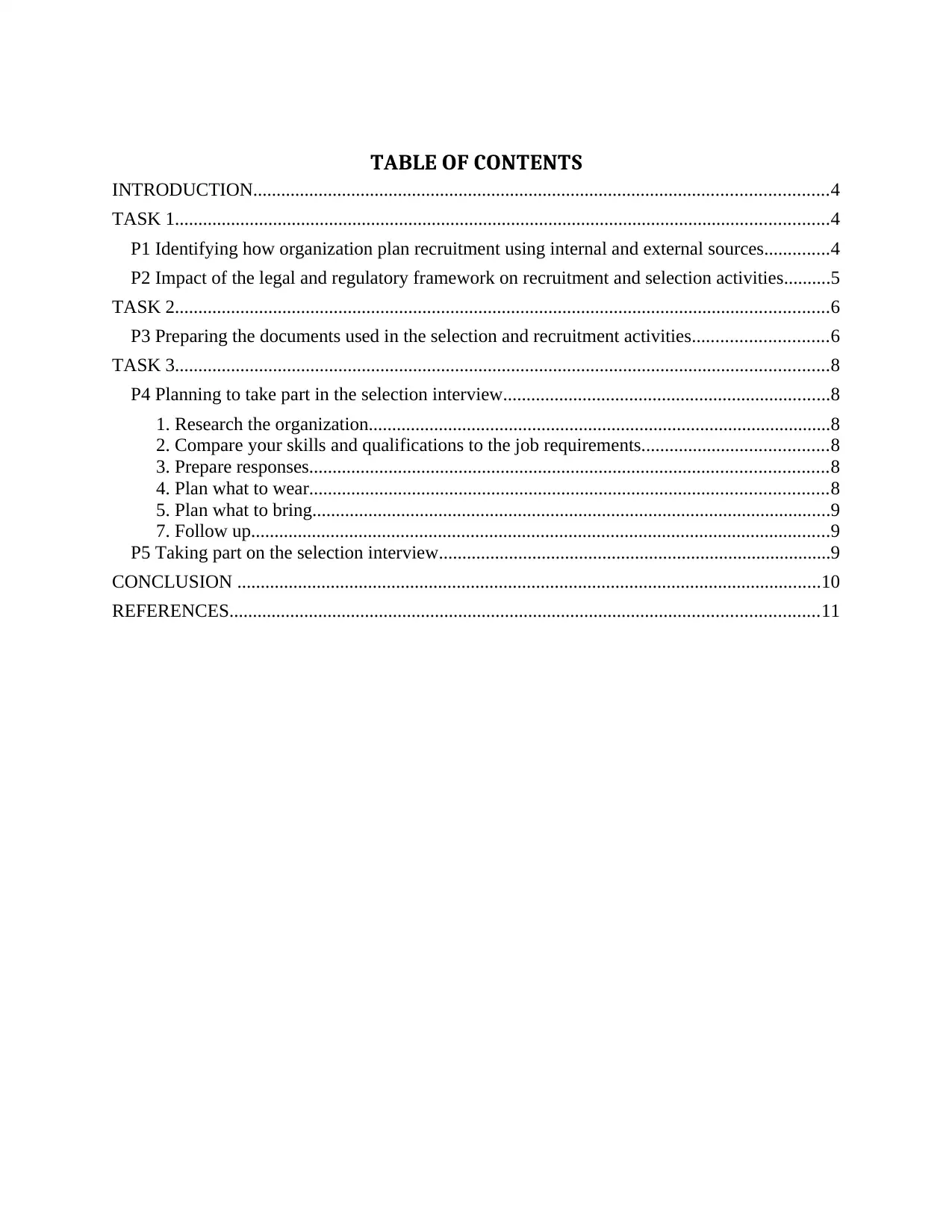
TABLE OF CONTENTS
INTRODUCTION...........................................................................................................................4
TASK 1............................................................................................................................................4
P1 Identifying how organization plan recruitment using internal and external sources..............4
P2 Impact of the legal and regulatory framework on recruitment and selection activities..........5
TASK 2............................................................................................................................................6
P3 Preparing the documents used in the selection and recruitment activities.............................6
TASK 3............................................................................................................................................8
P4 Planning to take part in the selection interview......................................................................8
1. Research the organization...................................................................................................8
2. Compare your skills and qualifications to the job requirements........................................8
3. Prepare responses...............................................................................................................8
4. Plan what to wear...............................................................................................................8
5. Plan what to bring...............................................................................................................9
7. Follow up............................................................................................................................9
P5 Taking part on the selection interview....................................................................................9
CONCLUSION .............................................................................................................................10
REFERENCES..............................................................................................................................11
INTRODUCTION...........................................................................................................................4
TASK 1............................................................................................................................................4
P1 Identifying how organization plan recruitment using internal and external sources..............4
P2 Impact of the legal and regulatory framework on recruitment and selection activities..........5
TASK 2............................................................................................................................................6
P3 Preparing the documents used in the selection and recruitment activities.............................6
TASK 3............................................................................................................................................8
P4 Planning to take part in the selection interview......................................................................8
1. Research the organization...................................................................................................8
2. Compare your skills and qualifications to the job requirements........................................8
3. Prepare responses...............................................................................................................8
4. Plan what to wear...............................................................................................................8
5. Plan what to bring...............................................................................................................9
7. Follow up............................................................................................................................9
P5 Taking part on the selection interview....................................................................................9
CONCLUSION .............................................................................................................................10
REFERENCES..............................................................................................................................11

⊘ This is a preview!⊘
Do you want full access?
Subscribe today to unlock all pages.

Trusted by 1+ million students worldwide
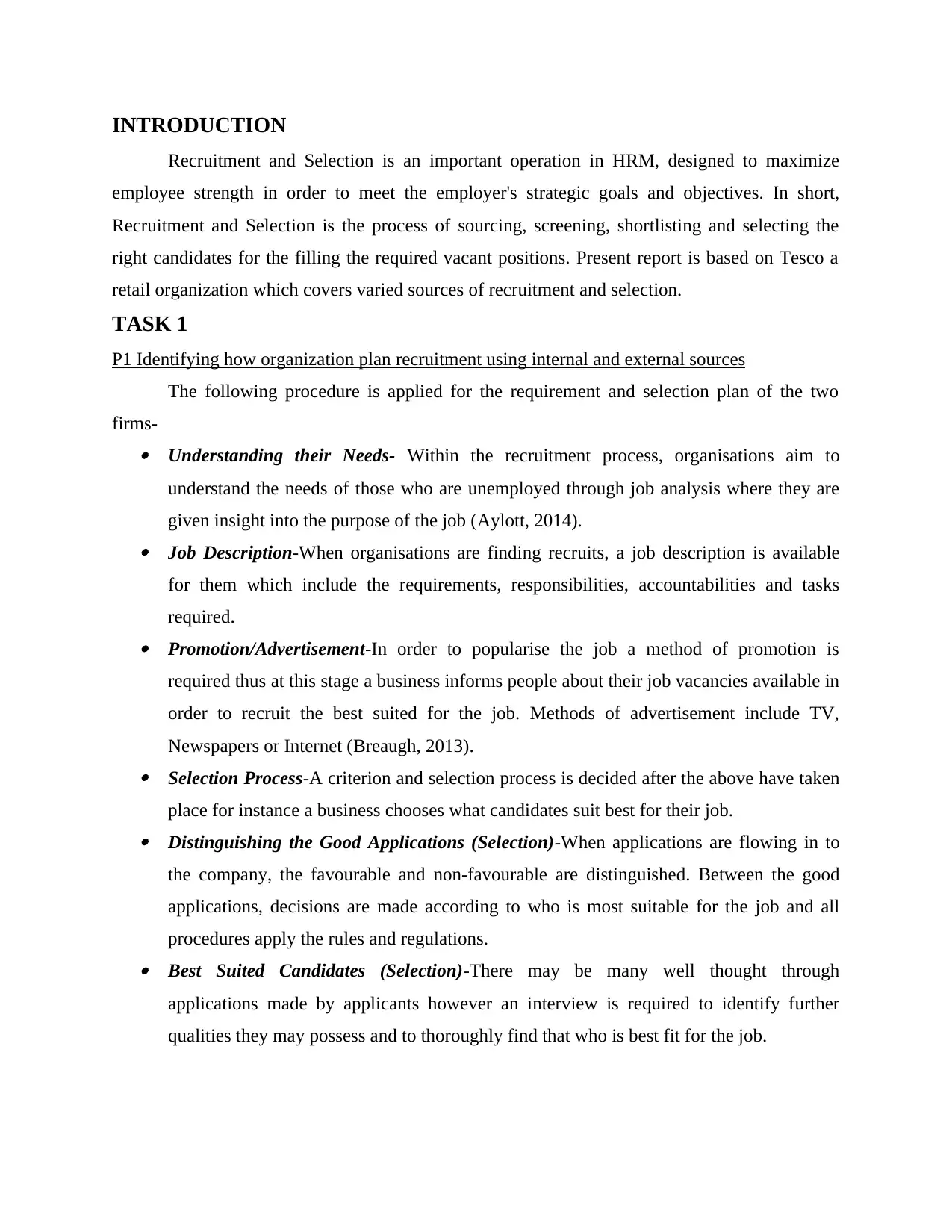
INTRODUCTION
Recruitment and Selection is an important operation in HRM, designed to maximize
employee strength in order to meet the employer's strategic goals and objectives. In short,
Recruitment and Selection is the process of sourcing, screening, shortlisting and selecting the
right candidates for the filling the required vacant positions. Present report is based on Tesco a
retail organization which covers varied sources of recruitment and selection.
TASK 1
P1 Identifying how organization plan recruitment using internal and external sources
The following procedure is applied for the requirement and selection plan of the two
firms- Understanding their Needs- Within the recruitment process, organisations aim to
understand the needs of those who are unemployed through job analysis where they are
given insight into the purpose of the job (Aylott, 2014). Job Description-When organisations are finding recruits, a job description is available
for them which include the requirements, responsibilities, accountabilities and tasks
required. Promotion/Advertisement-In order to popularise the job a method of promotion is
required thus at this stage a business informs people about their job vacancies available in
order to recruit the best suited for the job. Methods of advertisement include TV,
Newspapers or Internet (Breaugh, 2013). Selection Process-A criterion and selection process is decided after the above have taken
place for instance a business chooses what candidates suit best for their job. Distinguishing the Good Applications (Selection)-When applications are flowing in to
the company, the favourable and non-favourable are distinguished. Between the good
applications, decisions are made according to who is most suitable for the job and all
procedures apply the rules and regulations. Best Suited Candidates (Selection)-There may be many well thought through
applications made by applicants however an interview is required to identify further
qualities they may possess and to thoroughly find that who is best fit for the job.
Recruitment and Selection is an important operation in HRM, designed to maximize
employee strength in order to meet the employer's strategic goals and objectives. In short,
Recruitment and Selection is the process of sourcing, screening, shortlisting and selecting the
right candidates for the filling the required vacant positions. Present report is based on Tesco a
retail organization which covers varied sources of recruitment and selection.
TASK 1
P1 Identifying how organization plan recruitment using internal and external sources
The following procedure is applied for the requirement and selection plan of the two
firms- Understanding their Needs- Within the recruitment process, organisations aim to
understand the needs of those who are unemployed through job analysis where they are
given insight into the purpose of the job (Aylott, 2014). Job Description-When organisations are finding recruits, a job description is available
for them which include the requirements, responsibilities, accountabilities and tasks
required. Promotion/Advertisement-In order to popularise the job a method of promotion is
required thus at this stage a business informs people about their job vacancies available in
order to recruit the best suited for the job. Methods of advertisement include TV,
Newspapers or Internet (Breaugh, 2013). Selection Process-A criterion and selection process is decided after the above have taken
place for instance a business chooses what candidates suit best for their job. Distinguishing the Good Applications (Selection)-When applications are flowing in to
the company, the favourable and non-favourable are distinguished. Between the good
applications, decisions are made according to who is most suitable for the job and all
procedures apply the rules and regulations. Best Suited Candidates (Selection)-There may be many well thought through
applications made by applicants however an interview is required to identify further
qualities they may possess and to thoroughly find that who is best fit for the job.
Paraphrase This Document
Need a fresh take? Get an instant paraphrase of this document with our AI Paraphraser
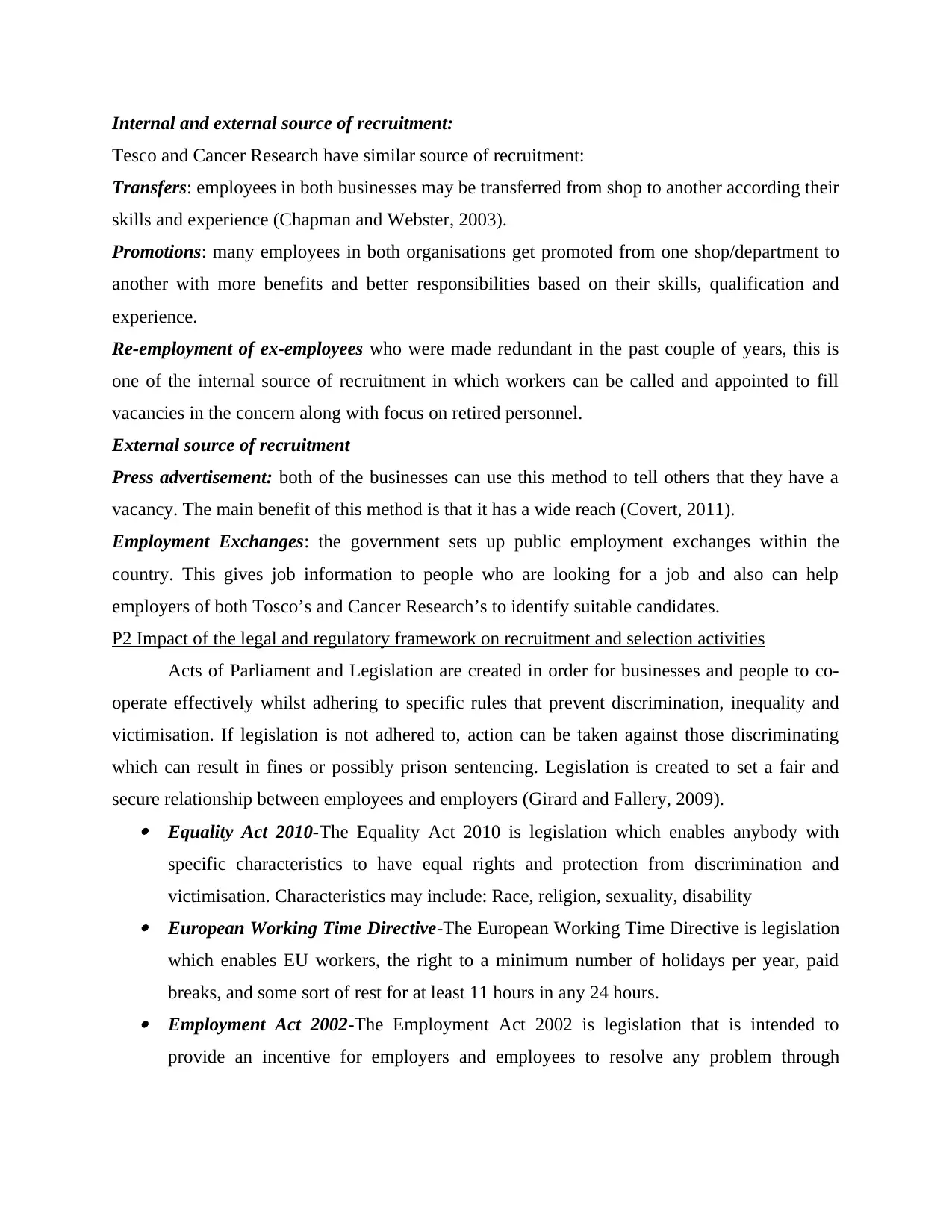
Internal and external source of recruitment:
Tesco and Cancer Research have similar source of recruitment:
Transfers: employees in both businesses may be transferred from shop to another according their
skills and experience (Chapman and Webster, 2003).
Promotions: many employees in both organisations get promoted from one shop/department to
another with more benefits and better responsibilities based on their skills, qualification and
experience.
Re-employment of ex-employees who were made redundant in the past couple of years, this is
one of the internal source of recruitment in which workers can be called and appointed to fill
vacancies in the concern along with focus on retired personnel.
External source of recruitment
Press advertisement: both of the businesses can use this method to tell others that they have a
vacancy. The main benefit of this method is that it has a wide reach (Covert, 2011).
Employment Exchanges: the government sets up public employment exchanges within the
country. This gives job information to people who are looking for a job and also can help
employers of both Tosco’s and Cancer Research’s to identify suitable candidates.
P2 Impact of the legal and regulatory framework on recruitment and selection activities
Acts of Parliament and Legislation are created in order for businesses and people to co-
operate effectively whilst adhering to specific rules that prevent discrimination, inequality and
victimisation. If legislation is not adhered to, action can be taken against those discriminating
which can result in fines or possibly prison sentencing. Legislation is created to set a fair and
secure relationship between employees and employers (Girard and Fallery, 2009). Equality Act 2010-The Equality Act 2010 is legislation which enables anybody with
specific characteristics to have equal rights and protection from discrimination and
victimisation. Characteristics may include: Race, religion, sexuality, disability European Working Time Directive-The European Working Time Directive is legislation
which enables EU workers, the right to a minimum number of holidays per year, paid
breaks, and some sort of rest for at least 11 hours in any 24 hours. Employment Act 2002-The Employment Act 2002 is legislation that is intended to
provide an incentive for employers and employees to resolve any problem through
Tesco and Cancer Research have similar source of recruitment:
Transfers: employees in both businesses may be transferred from shop to another according their
skills and experience (Chapman and Webster, 2003).
Promotions: many employees in both organisations get promoted from one shop/department to
another with more benefits and better responsibilities based on their skills, qualification and
experience.
Re-employment of ex-employees who were made redundant in the past couple of years, this is
one of the internal source of recruitment in which workers can be called and appointed to fill
vacancies in the concern along with focus on retired personnel.
External source of recruitment
Press advertisement: both of the businesses can use this method to tell others that they have a
vacancy. The main benefit of this method is that it has a wide reach (Covert, 2011).
Employment Exchanges: the government sets up public employment exchanges within the
country. This gives job information to people who are looking for a job and also can help
employers of both Tosco’s and Cancer Research’s to identify suitable candidates.
P2 Impact of the legal and regulatory framework on recruitment and selection activities
Acts of Parliament and Legislation are created in order for businesses and people to co-
operate effectively whilst adhering to specific rules that prevent discrimination, inequality and
victimisation. If legislation is not adhered to, action can be taken against those discriminating
which can result in fines or possibly prison sentencing. Legislation is created to set a fair and
secure relationship between employees and employers (Girard and Fallery, 2009). Equality Act 2010-The Equality Act 2010 is legislation which enables anybody with
specific characteristics to have equal rights and protection from discrimination and
victimisation. Characteristics may include: Race, religion, sexuality, disability European Working Time Directive-The European Working Time Directive is legislation
which enables EU workers, the right to a minimum number of holidays per year, paid
breaks, and some sort of rest for at least 11 hours in any 24 hours. Employment Act 2002-The Employment Act 2002 is legislation that is intended to
provide an incentive for employers and employees to resolve any problem through
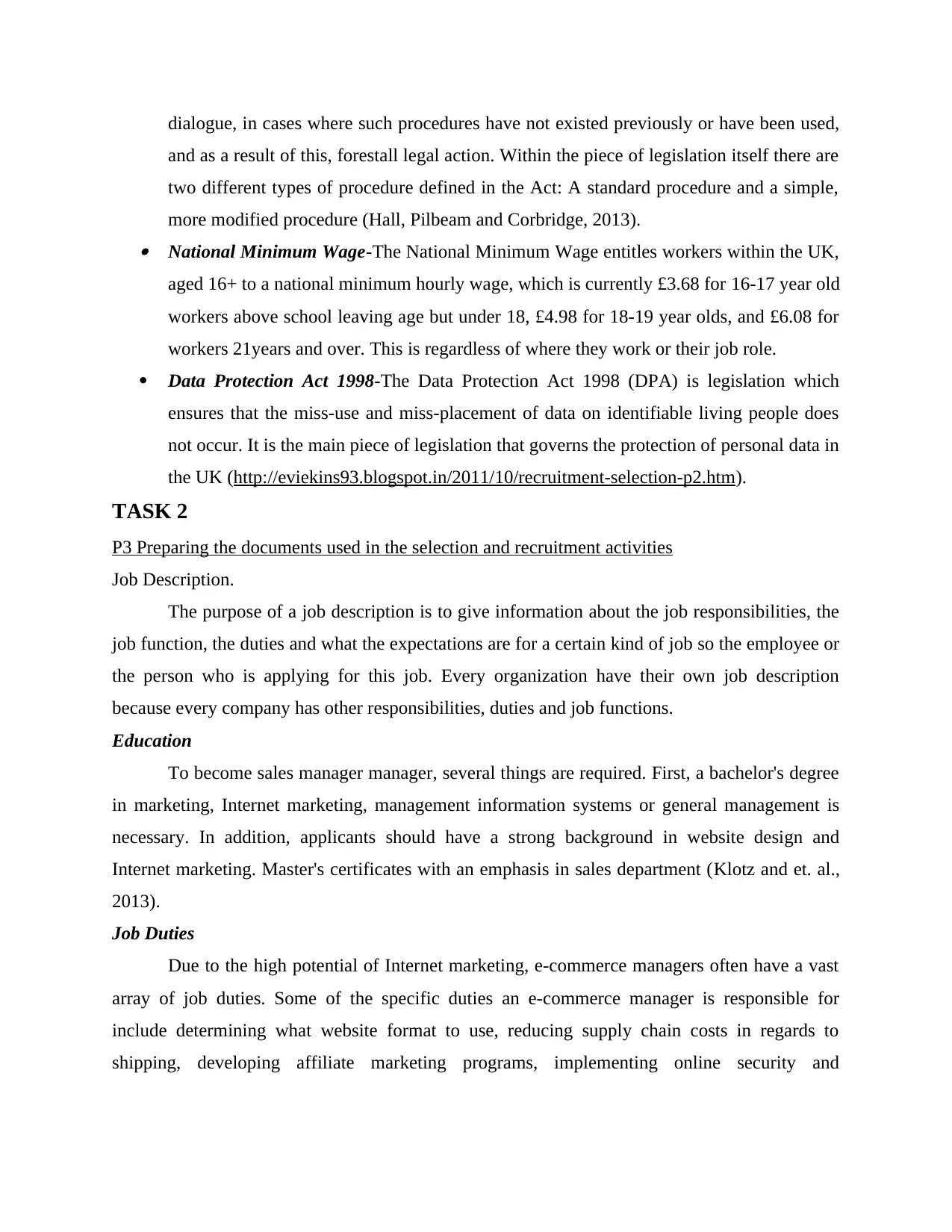
dialogue, in cases where such procedures have not existed previously or have been used,
and as a result of this, forestall legal action. Within the piece of legislation itself there are
two different types of procedure defined in the Act: A standard procedure and a simple,
more modified procedure (Hall, Pilbeam and Corbridge, 2013). National Minimum Wage-The National Minimum Wage entitles workers within the UK,
aged 16+ to a national minimum hourly wage, which is currently £3.68 for 16-17 year old
workers above school leaving age but under 18, £4.98 for 18-19 year olds, and £6.08 for
workers 21years and over. This is regardless of where they work or their job role.
Data Protection Act 1998-The Data Protection Act 1998 (DPA) is legislation which
ensures that the miss-use and miss-placement of data on identifiable living people does
not occur. It is the main piece of legislation that governs the protection of personal data in
the UK (http://eviekins93.blogspot.in/2011/10/recruitment-selection-p2.htm).
TASK 2
P3 Preparing the documents used in the selection and recruitment activities
Job Description.
The purpose of a job description is to give information about the job responsibilities, the
job function, the duties and what the expectations are for a certain kind of job so the employee or
the person who is applying for this job. Every organization have their own job description
because every company has other responsibilities, duties and job functions.
Education
To become sales manager manager, several things are required. First, a bachelor's degree
in marketing, Internet marketing, management information systems or general management is
necessary. In addition, applicants should have a strong background in website design and
Internet marketing. Master's certificates with an emphasis in sales department (Klotz and et. al.,
2013).
Job Duties
Due to the high potential of Internet marketing, e-commerce managers often have a vast
array of job duties. Some of the specific duties an e-commerce manager is responsible for
include determining what website format to use, reducing supply chain costs in regards to
shipping, developing affiliate marketing programs, implementing online security and
and as a result of this, forestall legal action. Within the piece of legislation itself there are
two different types of procedure defined in the Act: A standard procedure and a simple,
more modified procedure (Hall, Pilbeam and Corbridge, 2013). National Minimum Wage-The National Minimum Wage entitles workers within the UK,
aged 16+ to a national minimum hourly wage, which is currently £3.68 for 16-17 year old
workers above school leaving age but under 18, £4.98 for 18-19 year olds, and £6.08 for
workers 21years and over. This is regardless of where they work or their job role.
Data Protection Act 1998-The Data Protection Act 1998 (DPA) is legislation which
ensures that the miss-use and miss-placement of data on identifiable living people does
not occur. It is the main piece of legislation that governs the protection of personal data in
the UK (http://eviekins93.blogspot.in/2011/10/recruitment-selection-p2.htm).
TASK 2
P3 Preparing the documents used in the selection and recruitment activities
Job Description.
The purpose of a job description is to give information about the job responsibilities, the
job function, the duties and what the expectations are for a certain kind of job so the employee or
the person who is applying for this job. Every organization have their own job description
because every company has other responsibilities, duties and job functions.
Education
To become sales manager manager, several things are required. First, a bachelor's degree
in marketing, Internet marketing, management information systems or general management is
necessary. In addition, applicants should have a strong background in website design and
Internet marketing. Master's certificates with an emphasis in sales department (Klotz and et. al.,
2013).
Job Duties
Due to the high potential of Internet marketing, e-commerce managers often have a vast
array of job duties. Some of the specific duties an e-commerce manager is responsible for
include determining what website format to use, reducing supply chain costs in regards to
shipping, developing affiliate marketing programs, implementing online security and
⊘ This is a preview!⊘
Do you want full access?
Subscribe today to unlock all pages.

Trusted by 1+ million students worldwide
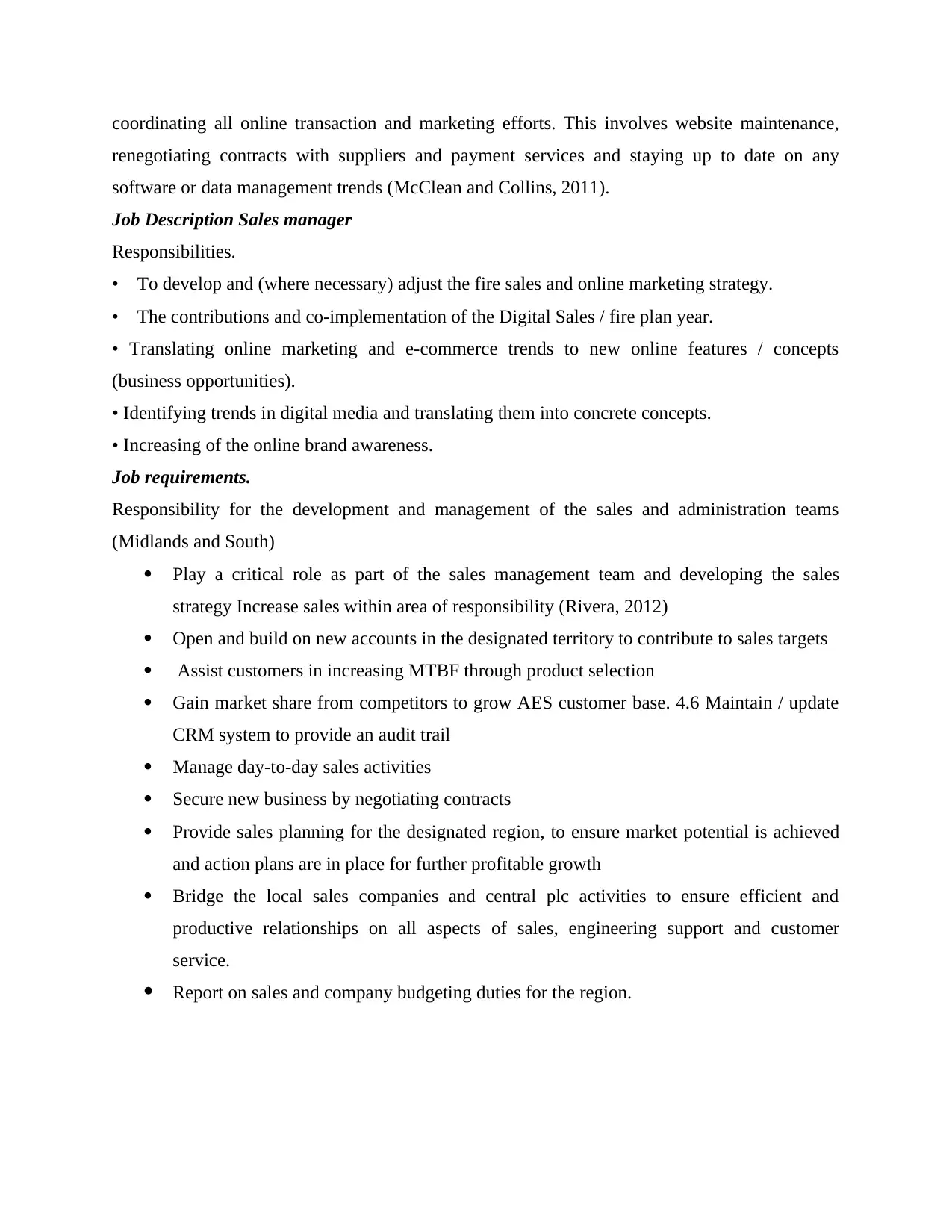
coordinating all online transaction and marketing efforts. This involves website maintenance,
renegotiating contracts with suppliers and payment services and staying up to date on any
software or data management trends (McClean and Collins, 2011).
Job Description Sales manager
Responsibilities.
• To develop and (where necessary) adjust the fire sales and online marketing strategy.
• The contributions and co-implementation of the Digital Sales / fire plan year.
• Translating online marketing and e-commerce trends to new online features / concepts
(business opportunities).
• Identifying trends in digital media and translating them into concrete concepts.
• Increasing of the online brand awareness.
Job requirements.
Responsibility for the development and management of the sales and administration teams
(Midlands and South)
Play a critical role as part of the sales management team and developing the sales
strategy Increase sales within area of responsibility (Rivera, 2012)
Open and build on new accounts in the designated territory to contribute to sales targets
Assist customers in increasing MTBF through product selection
Gain market share from competitors to grow AES customer base. 4.6 Maintain / update
CRM system to provide an audit trail
Manage day-to-day sales activities
Secure new business by negotiating contracts
Provide sales planning for the designated region, to ensure market potential is achieved
and action plans are in place for further profitable growth
Bridge the local sales companies and central plc activities to ensure efficient and
productive relationships on all aspects of sales, engineering support and customer
service.
Report on sales and company budgeting duties for the region.
renegotiating contracts with suppliers and payment services and staying up to date on any
software or data management trends (McClean and Collins, 2011).
Job Description Sales manager
Responsibilities.
• To develop and (where necessary) adjust the fire sales and online marketing strategy.
• The contributions and co-implementation of the Digital Sales / fire plan year.
• Translating online marketing and e-commerce trends to new online features / concepts
(business opportunities).
• Identifying trends in digital media and translating them into concrete concepts.
• Increasing of the online brand awareness.
Job requirements.
Responsibility for the development and management of the sales and administration teams
(Midlands and South)
Play a critical role as part of the sales management team and developing the sales
strategy Increase sales within area of responsibility (Rivera, 2012)
Open and build on new accounts in the designated territory to contribute to sales targets
Assist customers in increasing MTBF through product selection
Gain market share from competitors to grow AES customer base. 4.6 Maintain / update
CRM system to provide an audit trail
Manage day-to-day sales activities
Secure new business by negotiating contracts
Provide sales planning for the designated region, to ensure market potential is achieved
and action plans are in place for further profitable growth
Bridge the local sales companies and central plc activities to ensure efficient and
productive relationships on all aspects of sales, engineering support and customer
service.
Report on sales and company budgeting duties for the region.
Paraphrase This Document
Need a fresh take? Get an instant paraphrase of this document with our AI Paraphraser
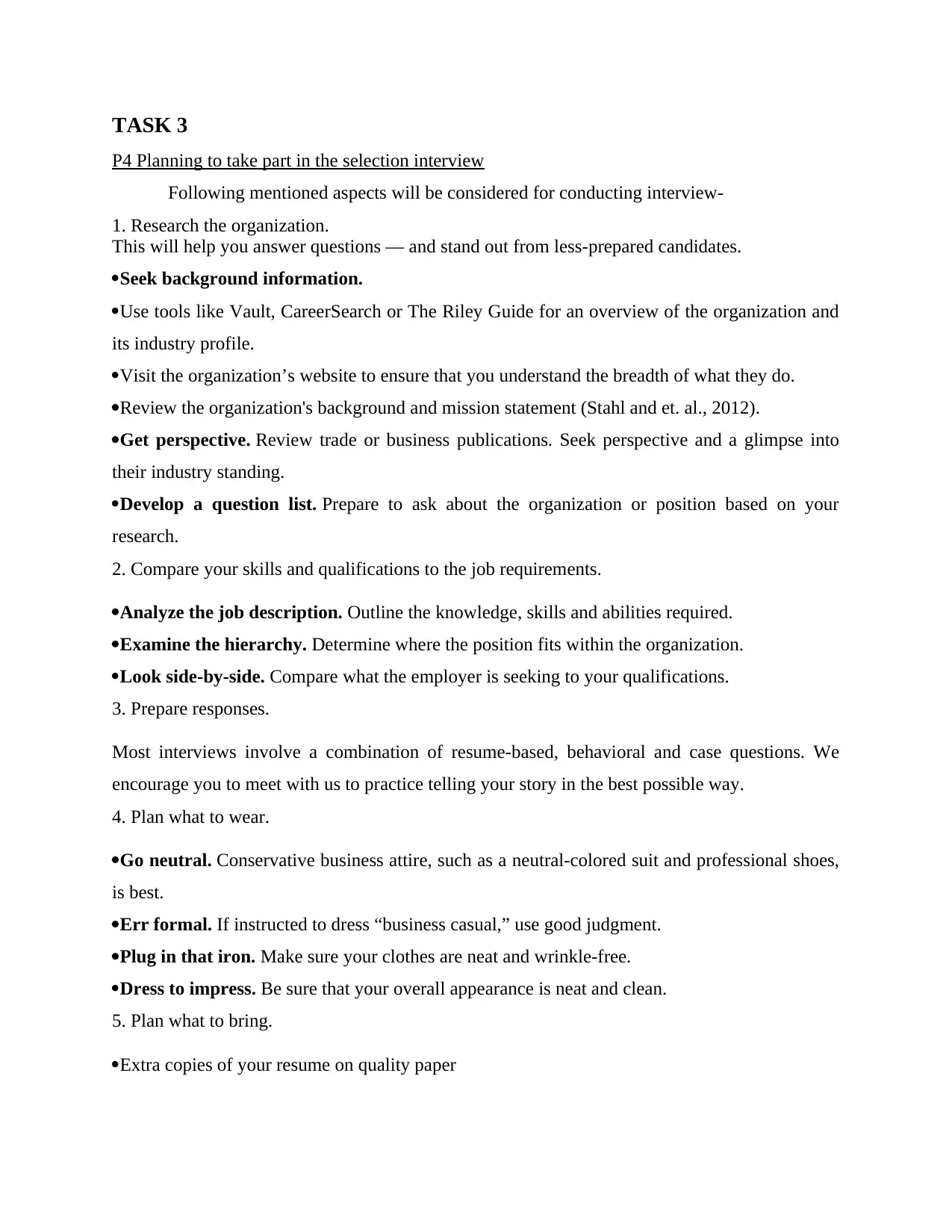
TASK 3
P4 Planning to take part in the selection interview
Following mentioned aspects will be considered for conducting interview-
1. Research the organization.
This will help you answer questions — and stand out from less-prepared candidates.
Seek background information.
Use tools like Vault, CareerSearch or The Riley Guide for an overview of the organization and
its industry profile.
Visit the organization’s website to ensure that you understand the breadth of what they do.
Review the organization's background and mission statement (Stahl and et. al., 2012).
Get perspective. Review trade or business publications. Seek perspective and a glimpse into
their industry standing.
Develop a question list. Prepare to ask about the organization or position based on your
research.
2. Compare your skills and qualifications to the job requirements.
Analyze the job description. Outline the knowledge, skills and abilities required.
Examine the hierarchy. Determine where the position fits within the organization.
Look side-by-side. Compare what the employer is seeking to your qualifications.
3. Prepare responses.
Most interviews involve a combination of resume-based, behavioral and case questions. We
encourage you to meet with us to practice telling your story in the best possible way.
4. Plan what to wear.
Go neutral. Conservative business attire, such as a neutral-colored suit and professional shoes,
is best.
Err formal. If instructed to dress “business casual,” use good judgment.
Plug in that iron. Make sure your clothes are neat and wrinkle-free.
Dress to impress. Be sure that your overall appearance is neat and clean.
5. Plan what to bring.
Extra copies of your resume on quality paper
P4 Planning to take part in the selection interview
Following mentioned aspects will be considered for conducting interview-
1. Research the organization.
This will help you answer questions — and stand out from less-prepared candidates.
Seek background information.
Use tools like Vault, CareerSearch or The Riley Guide for an overview of the organization and
its industry profile.
Visit the organization’s website to ensure that you understand the breadth of what they do.
Review the organization's background and mission statement (Stahl and et. al., 2012).
Get perspective. Review trade or business publications. Seek perspective and a glimpse into
their industry standing.
Develop a question list. Prepare to ask about the organization or position based on your
research.
2. Compare your skills and qualifications to the job requirements.
Analyze the job description. Outline the knowledge, skills and abilities required.
Examine the hierarchy. Determine where the position fits within the organization.
Look side-by-side. Compare what the employer is seeking to your qualifications.
3. Prepare responses.
Most interviews involve a combination of resume-based, behavioral and case questions. We
encourage you to meet with us to practice telling your story in the best possible way.
4. Plan what to wear.
Go neutral. Conservative business attire, such as a neutral-colored suit and professional shoes,
is best.
Err formal. If instructed to dress “business casual,” use good judgment.
Plug in that iron. Make sure your clothes are neat and wrinkle-free.
Dress to impress. Be sure that your overall appearance is neat and clean.
5. Plan what to bring.
Extra copies of your resume on quality paper
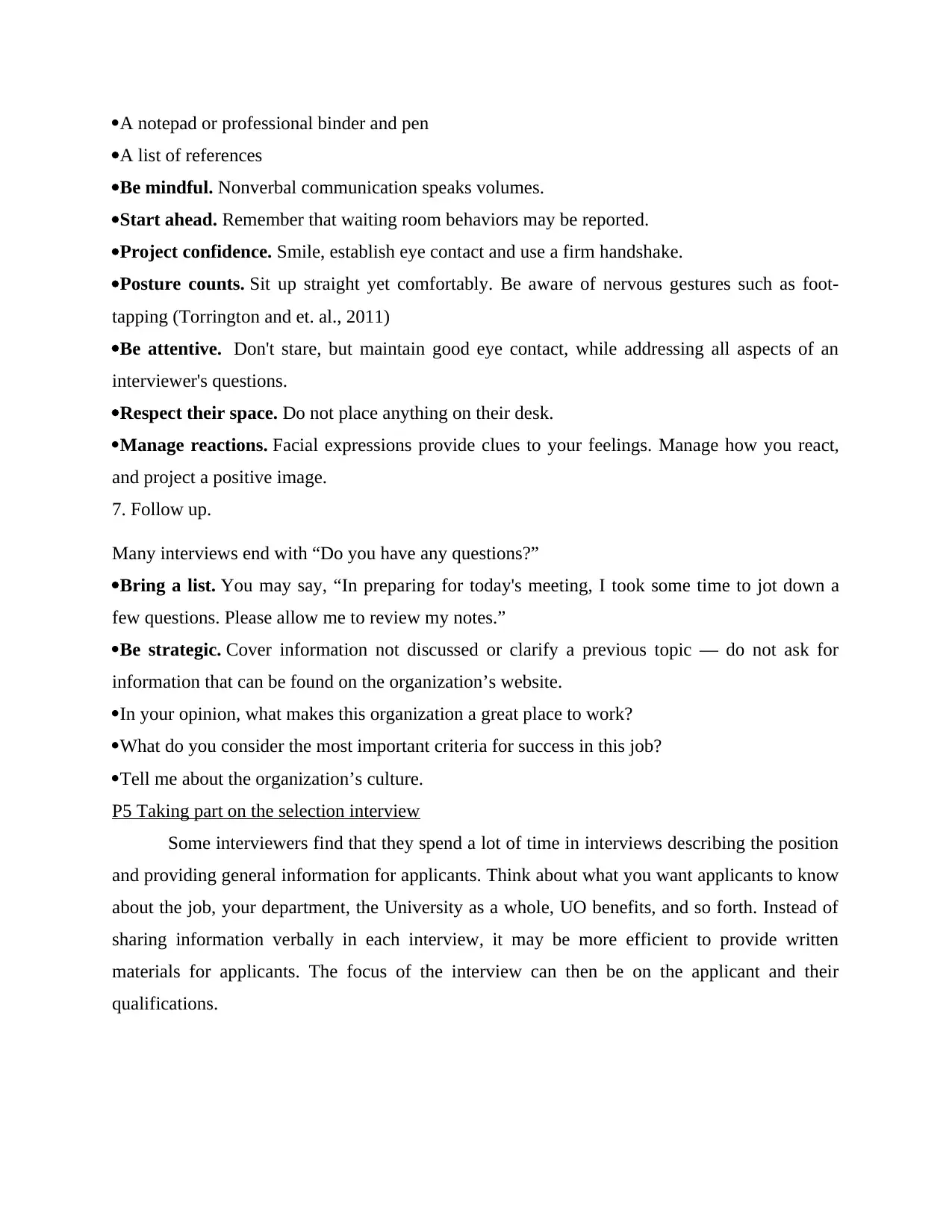
A notepad or professional binder and pen
A list of references
Be mindful. Nonverbal communication speaks volumes.
Start ahead. Remember that waiting room behaviors may be reported.
Project confidence. Smile, establish eye contact and use a firm handshake.
Posture counts. Sit up straight yet comfortably. Be aware of nervous gestures such as foot-
tapping (Torrington and et. al., 2011)
Be attentive. Don't stare, but maintain good eye contact, while addressing all aspects of an
interviewer's questions.
Respect their space. Do not place anything on their desk.
Manage reactions. Facial expressions provide clues to your feelings. Manage how you react,
and project a positive image.
7. Follow up.
Many interviews end with “Do you have any questions?”
Bring a list. You may say, “In preparing for today's meeting, I took some time to jot down a
few questions. Please allow me to review my notes.”
Be strategic. Cover information not discussed or clarify a previous topic — do not ask for
information that can be found on the organization’s website.
In your opinion, what makes this organization a great place to work?
What do you consider the most important criteria for success in this job?
Tell me about the organization’s culture.
P5 Taking part on the selection interview
Some interviewers find that they spend a lot of time in interviews describing the position
and providing general information for applicants. Think about what you want applicants to know
about the job, your department, the University as a whole, UO benefits, and so forth. Instead of
sharing information verbally in each interview, it may be more efficient to provide written
materials for applicants. The focus of the interview can then be on the applicant and their
qualifications.
A list of references
Be mindful. Nonverbal communication speaks volumes.
Start ahead. Remember that waiting room behaviors may be reported.
Project confidence. Smile, establish eye contact and use a firm handshake.
Posture counts. Sit up straight yet comfortably. Be aware of nervous gestures such as foot-
tapping (Torrington and et. al., 2011)
Be attentive. Don't stare, but maintain good eye contact, while addressing all aspects of an
interviewer's questions.
Respect their space. Do not place anything on their desk.
Manage reactions. Facial expressions provide clues to your feelings. Manage how you react,
and project a positive image.
7. Follow up.
Many interviews end with “Do you have any questions?”
Bring a list. You may say, “In preparing for today's meeting, I took some time to jot down a
few questions. Please allow me to review my notes.”
Be strategic. Cover information not discussed or clarify a previous topic — do not ask for
information that can be found on the organization’s website.
In your opinion, what makes this organization a great place to work?
What do you consider the most important criteria for success in this job?
Tell me about the organization’s culture.
P5 Taking part on the selection interview
Some interviewers find that they spend a lot of time in interviews describing the position
and providing general information for applicants. Think about what you want applicants to know
about the job, your department, the University as a whole, UO benefits, and so forth. Instead of
sharing information verbally in each interview, it may be more efficient to provide written
materials for applicants. The focus of the interview can then be on the applicant and their
qualifications.
⊘ This is a preview!⊘
Do you want full access?
Subscribe today to unlock all pages.

Trusted by 1+ million students worldwide
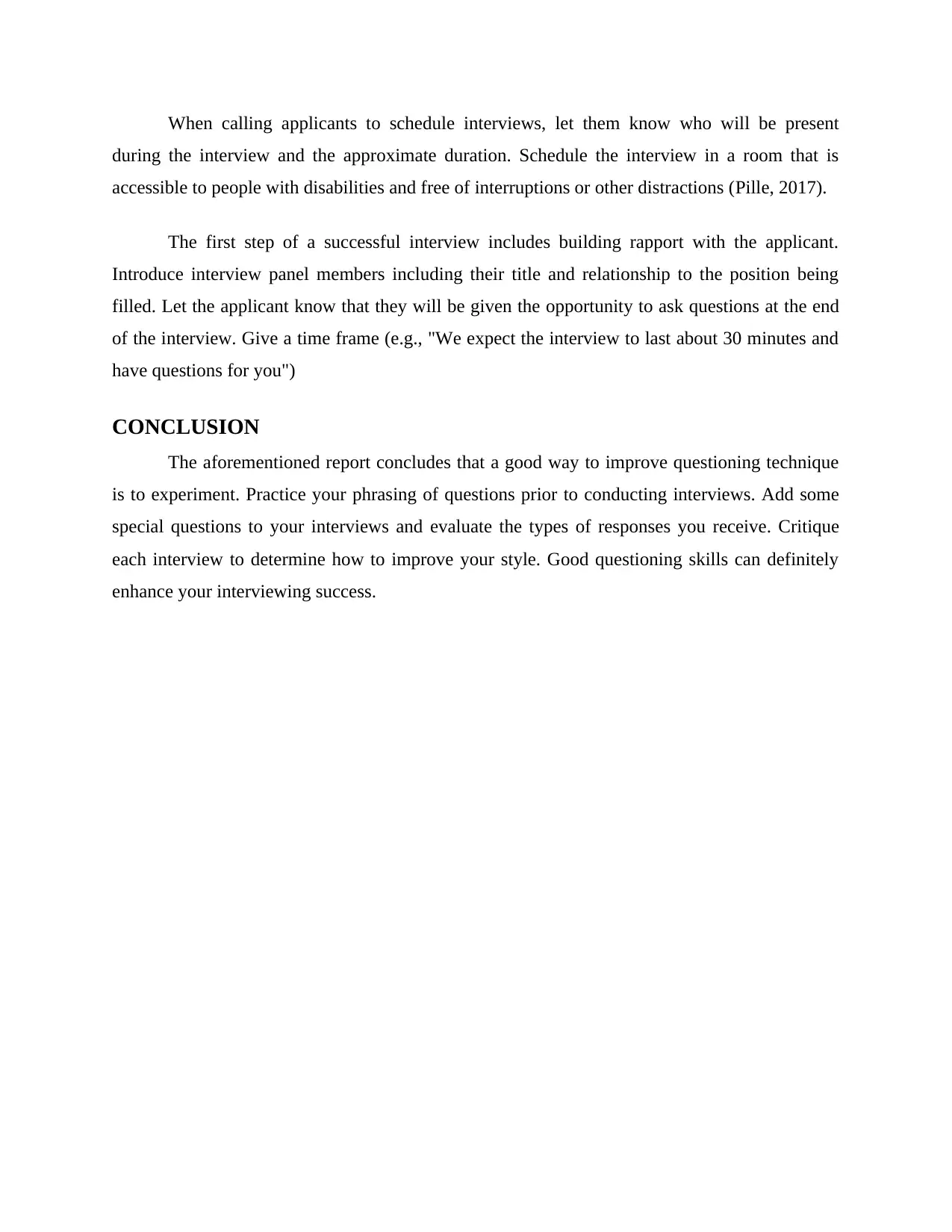
When calling applicants to schedule interviews, let them know who will be present
during the interview and the approximate duration. Schedule the interview in a room that is
accessible to people with disabilities and free of interruptions or other distractions (Pille, 2017).
The first step of a successful interview includes building rapport with the applicant.
Introduce interview panel members including their title and relationship to the position being
filled. Let the applicant know that they will be given the opportunity to ask questions at the end
of the interview. Give a time frame (e.g., "We expect the interview to last about 30 minutes and
have questions for you")
CONCLUSION
The aforementioned report concludes that a good way to improve questioning technique
is to experiment. Practice your phrasing of questions prior to conducting interviews. Add some
special questions to your interviews and evaluate the types of responses you receive. Critique
each interview to determine how to improve your style. Good questioning skills can definitely
enhance your interviewing success.
during the interview and the approximate duration. Schedule the interview in a room that is
accessible to people with disabilities and free of interruptions or other distractions (Pille, 2017).
The first step of a successful interview includes building rapport with the applicant.
Introduce interview panel members including their title and relationship to the position being
filled. Let the applicant know that they will be given the opportunity to ask questions at the end
of the interview. Give a time frame (e.g., "We expect the interview to last about 30 minutes and
have questions for you")
CONCLUSION
The aforementioned report concludes that a good way to improve questioning technique
is to experiment. Practice your phrasing of questions prior to conducting interviews. Add some
special questions to your interviews and evaluate the types of responses you receive. Critique
each interview to determine how to improve your style. Good questioning skills can definitely
enhance your interviewing success.
Paraphrase This Document
Need a fresh take? Get an instant paraphrase of this document with our AI Paraphraser
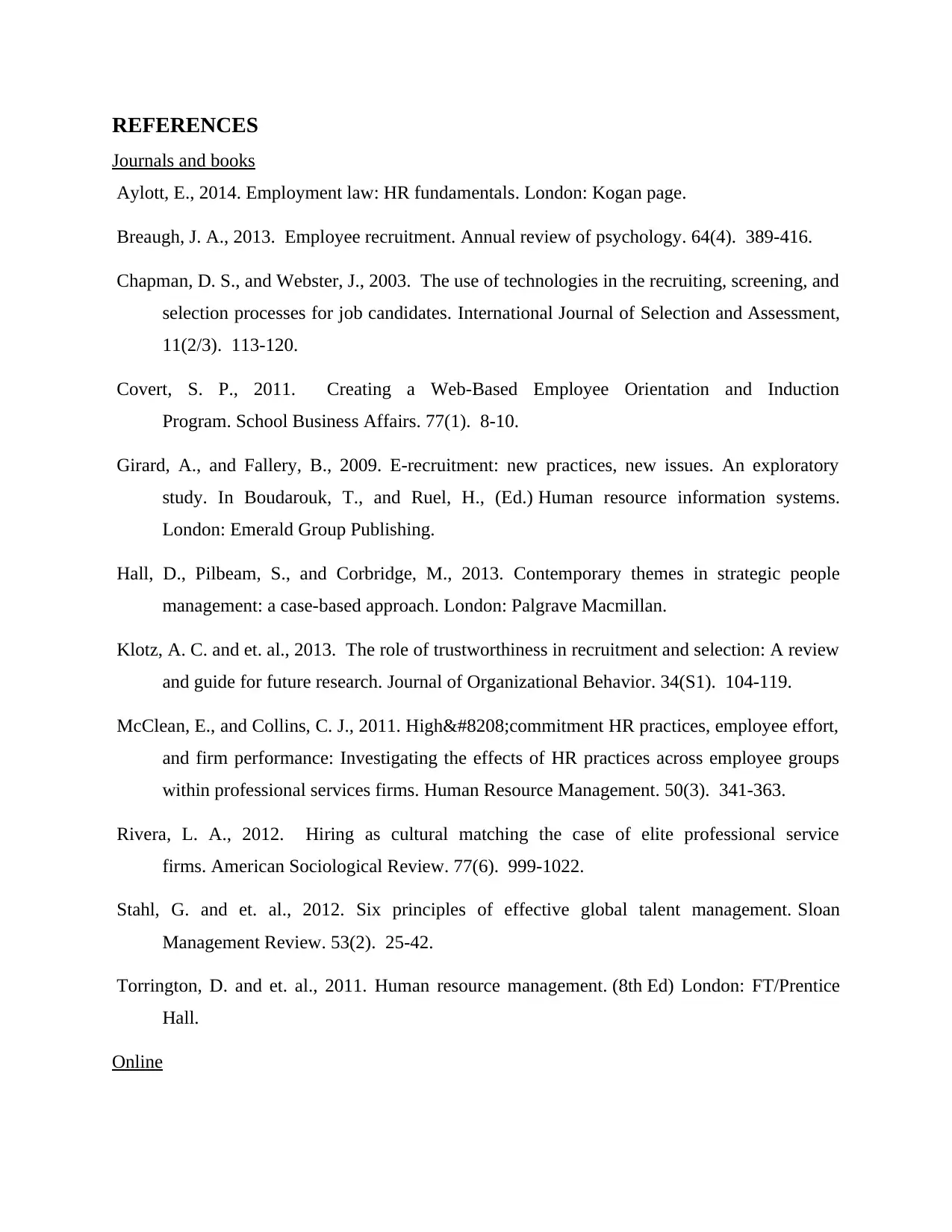
REFERENCES
Journals and books
Aylott, E., 2014. Employment law: HR fundamentals. London: Kogan page.
Breaugh, J. A., 2013. Employee recruitment. Annual review of psychology. 64(4). 389-416.
Chapman, D. S., and Webster, J., 2003. The use of technologies in the recruiting, screening, and
selection processes for job candidates. International Journal of Selection and Assessment,
11(2/3). 113-120.
Covert, S. P., 2011. Creating a Web-Based Employee Orientation and Induction
Program. School Business Affairs. 77(1). 8-10.
Girard, A., and Fallery, B., 2009. E-recruitment: new practices, new issues. An exploratory
study. In Boudarouk, T., and Ruel, H., (Ed.) Human resource information systems.
London: Emerald Group Publishing.
Hall, D., Pilbeam, S., and Corbridge, M., 2013. Contemporary themes in strategic people
management: a case-based approach. London: Palgrave Macmillan.
Klotz, A. C. and et. al., 2013. The role of trustworthiness in recruitment and selection: A review
and guide for future research. Journal of Organizational Behavior. 34(S1). 104-119.
McClean, E., and Collins, C. J., 2011. High‐commitment HR practices, employee effort,
and firm performance: Investigating the effects of HR practices across employee groups
within professional services firms. Human Resource Management. 50(3). 341-363.
Rivera, L. A., 2012. Hiring as cultural matching the case of elite professional service
firms. American Sociological Review. 77(6). 999-1022.
Stahl, G. and et. al., 2012. Six principles of effective global talent management. Sloan
Management Review. 53(2). 25-42.
Torrington, D. and et. al., 2011. Human resource management. (8th Ed) London: FT/Prentice
Hall.
Online
Journals and books
Aylott, E., 2014. Employment law: HR fundamentals. London: Kogan page.
Breaugh, J. A., 2013. Employee recruitment. Annual review of psychology. 64(4). 389-416.
Chapman, D. S., and Webster, J., 2003. The use of technologies in the recruiting, screening, and
selection processes for job candidates. International Journal of Selection and Assessment,
11(2/3). 113-120.
Covert, S. P., 2011. Creating a Web-Based Employee Orientation and Induction
Program. School Business Affairs. 77(1). 8-10.
Girard, A., and Fallery, B., 2009. E-recruitment: new practices, new issues. An exploratory
study. In Boudarouk, T., and Ruel, H., (Ed.) Human resource information systems.
London: Emerald Group Publishing.
Hall, D., Pilbeam, S., and Corbridge, M., 2013. Contemporary themes in strategic people
management: a case-based approach. London: Palgrave Macmillan.
Klotz, A. C. and et. al., 2013. The role of trustworthiness in recruitment and selection: A review
and guide for future research. Journal of Organizational Behavior. 34(S1). 104-119.
McClean, E., and Collins, C. J., 2011. High‐commitment HR practices, employee effort,
and firm performance: Investigating the effects of HR practices across employee groups
within professional services firms. Human Resource Management. 50(3). 341-363.
Rivera, L. A., 2012. Hiring as cultural matching the case of elite professional service
firms. American Sociological Review. 77(6). 999-1022.
Stahl, G. and et. al., 2012. Six principles of effective global talent management. Sloan
Management Review. 53(2). 25-42.
Torrington, D. and et. al., 2011. Human resource management. (8th Ed) London: FT/Prentice
Hall.
Online
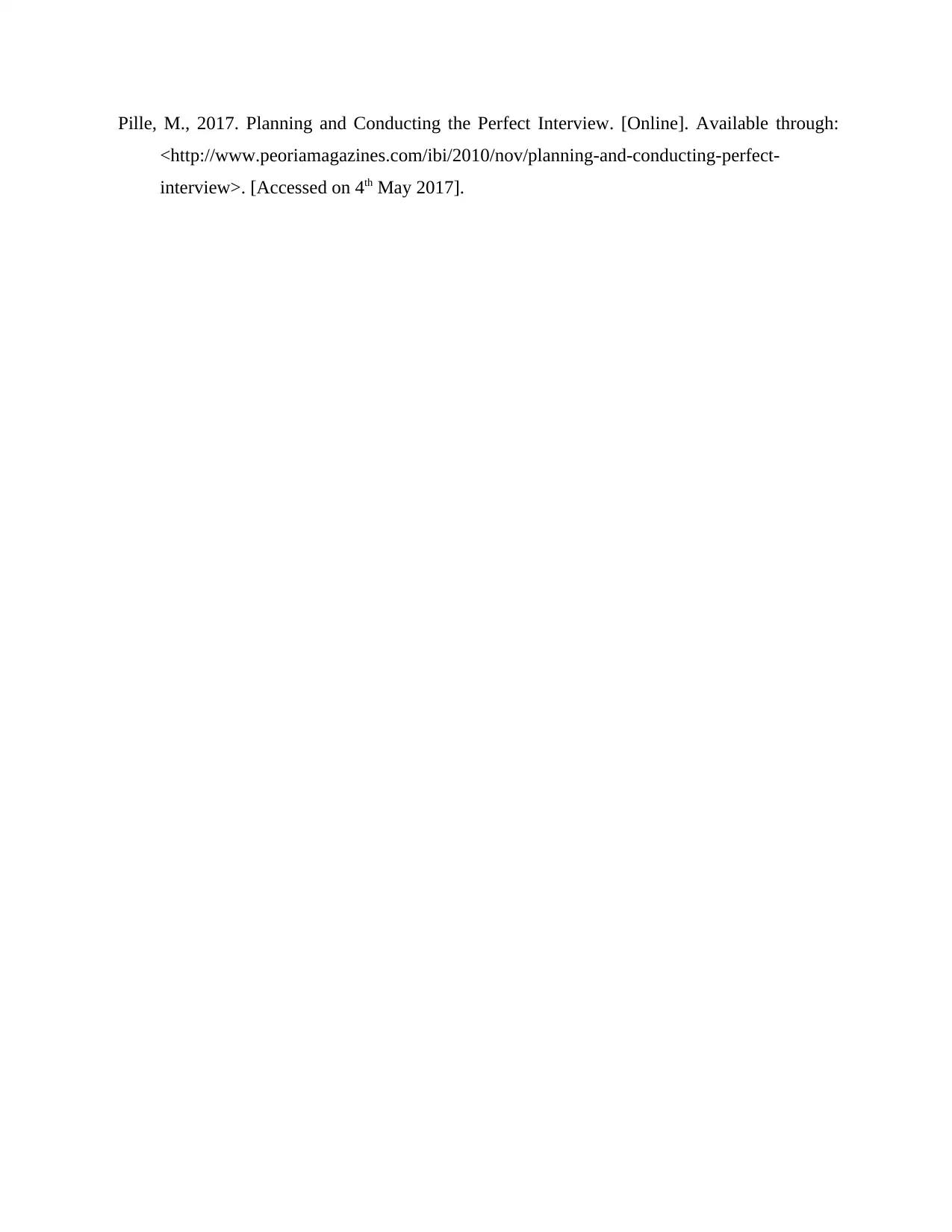
Pille, M., 2017. Planning and Conducting the Perfect Interview. [Online]. Available through:
<http://www.peoriamagazines.com/ibi/2010/nov/planning-and-conducting-perfect-
interview>. [Accessed on 4th May 2017].
<http://www.peoriamagazines.com/ibi/2010/nov/planning-and-conducting-perfect-
interview>. [Accessed on 4th May 2017].
⊘ This is a preview!⊘
Do you want full access?
Subscribe today to unlock all pages.

Trusted by 1+ million students worldwide
1 out of 12
Related Documents
Your All-in-One AI-Powered Toolkit for Academic Success.
+13062052269
info@desklib.com
Available 24*7 on WhatsApp / Email
![[object Object]](/_next/static/media/star-bottom.7253800d.svg)
Unlock your academic potential
Copyright © 2020–2025 A2Z Services. All Rights Reserved. Developed and managed by ZUCOL.





